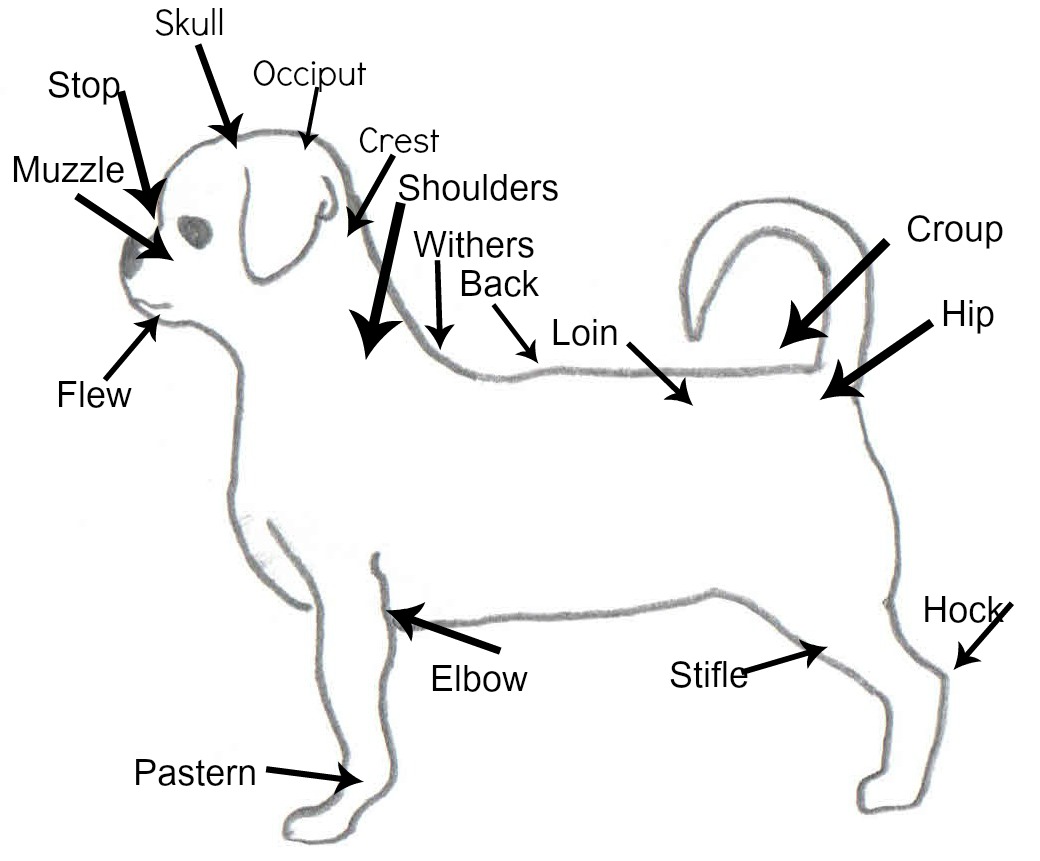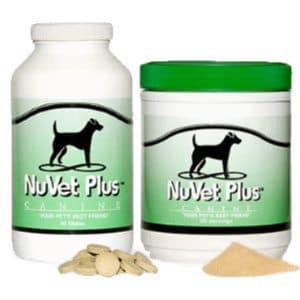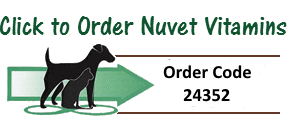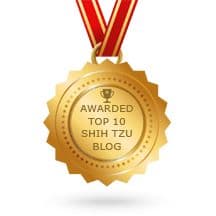- Home
- About the Shih Tzu
- Shih Tzu Standard
Shih Tzu Standard
by Janice Jones |Last Updated 07-14-2021
The Shih Tzu standard is the description written by the breed's parent club, the American Shih Tzu Club that describes what an ideal Shih Tzu should look and act like. Breeders strive to produce dogs as close to the standard as possible and dogs, but there is not a perfect dog.
When I first started with dogs, I didn't know the difference between a hock, a croup, or a stop. The terminology of the dog world was like learning a foreign language. To help you understand some of the terms, I've included this crude diagram so you will know your hock from your croup or stop!
The descriptive standard below can be found on the American Kennel Club website or from the parent club, the American Shih Tzu Club.
Each country has its own kennel club and unique breed standard, though most are all very similar
Dog Anatomy
Shih Tzu Standard: The General Appearance
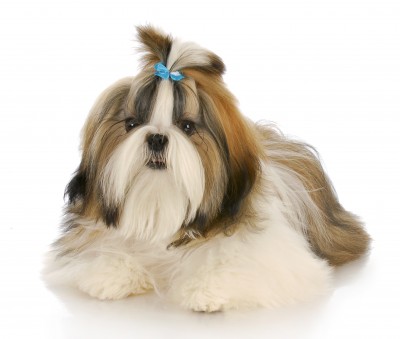 Parker (Tri-color Shih Tzu) from Ontario Canada
Parker (Tri-color Shih Tzu) from Ontario CanadaThe Standard is Courtesy of the AKC and American Shih Tzu Club
My personal comments and explanations are written in red for clarification purposes.
The Shih Tzu is a sturdy, lively, alert toy dog with long flowing double coat. Befitting his noble Chinese ancestry as a highly valued, prized companion and palace pet, the Shih Tzu is proud of bearing, has a distinctively arrogant carriage with head well up and tail curved over the back.
Although there has always been considerable size variation, the Shih Tzu must be compact, solid, carrying good weight and substance.Even though a toy dog, the Shih Tzu must be subject to the same requirements of soundness and structure prescribed for all breeds, and any deviation from the ideal described in the standard should be penalized to the extent of the deviation.
Structural faults common to all breeds are as undesirable in the Shih Tzu as in any other breed, regardless of whether or not such faults are specifically mentioned in the standard.
Bearing refers to the way the dog moves, stands and behaves.
Carriage: How the dog moves his head and body
Compact: Short Leg
Good Weight and Substance: Not too skinny, not too log
Shih Tzu Standard: Size, Proportion, Substance
Size
Ideally, height at withers is 9 to 10½ inches; but, not less than 8 inches nor more than 11 inches. Ideally, weight of mature dogs, 9 to 16 pounds.
Proportion
Length between withers and root of tail is slightly longer than height at withers. The Shih Tzu must never be so high stationed as to appear leggy, nor so low stationed as to appear dumpy or squatty.
Substance
Regardless of size, the Shih Tzu is always compact, solid and carries good weight and substance.
Height: measured with a ruler from his shoulders to the floor. After measuring his height, measure his back, from the point where you measured his height, just to the point where the tail attaches to the back.
High stationed: The relationship between body to the floor;
Always Compact: Whether a Shih Tzu is 9 pounds or 16, the weight will be distributed through the body but will not add to the length of the legs.
The Shih Tzu Standard: Head
Round, broad, wide between eyes, its size in balance with the overall size of dog being neither too large nor too small. Fault: Narrow head, close-set eyes.
Expression - Warm, sweet, wide-eyed, friendly and trusting. An overall well-balanced and pleasant expression supersedes the importance of individual parts. Care should be taken to look and examine well beyond the hair to determine if what is seen is the actual head and expression rather than an image created by grooming technique.
Eyes - Large, round, not prominent, placed well apart, looking straight ahead. Very dark. Lighter on liver pigmented dogs and blue pigmented dogs. Fault: Small, close-set or light eyes; excessive eye white.
Ears - Large, set slightly below crown of skull; heavily coated. Skull - Domed. Stop - There is a definite stop.
Muzzle - Square, short, unwrinkled, with good cushioning, set no lower than bottom eye rim; never downturned. Ideally, no longer than 1 inch from tip of nose to stop, although length may vary slightly in relation to overall size of dog. Front of muzzle should be flat; lower lip and chin not protruding and definitely never receding. Fault: Snipiness, lack of definite stop.
Nose - Nostrils are broad, wide, and open. Pigmentation - Nose, lips, eye rims are black on all colors, except liver on liver pigmented dogs and blue on blue pigmented dogs. Fault: Pink on nose, lips, or eye rims.
Bite - Undershot. Jaw is broad and wide. A missing tooth or slightly misaligned teeth should not be too severely penalized. Teeth and tongue should not show when mouth is closed. Fault: Overshot bite.
The stop is clearly seen.
The outer surfaces of the upper teeth meet the inner surface of the lower teeth. This is called a reverse scissor bite.
Shih Tzu Standard: Neck, Topline, Body
Of utmost importance is an overall well-balanced dog with no exaggerated features.
Neck
Well set-on flowing smoothly into shoulders; of sufficient length to permit natural high head carriage and in balance with height and length of dog.
Topline
Level. Body -Short-coupled and sturdy with no waist or tuck-up. The Shih Tzu is slightly longer than tall. Fault: Legginess.
Chest
Broad and deep with good spring-of-rib, however, not barrel-chested. Depth of ribcage should extend to just below elbow. Distance from elbow to withers is a little greater than from elbow to ground.
Croup
Flat
Tail
Set on high, heavily plumed, carried in curve well over back. Too loose, too tight, too flat, or too low set a tail is undesirable and should be penalized to extent of deviation.
Forequarters
Shoulders - Well-angulated, well laid-back, well laid-in, fitting smoothly into body. Legs - Straight, well-boned, muscular, set well-apart and under chest, with elbows set close to body. Pasterns - Strong, perpendicular. Dewclaws - May be removed. Feet - Firm, well-padded, point straight ahead.
Hindquarters
Angulation of hindquarters should be in balance with forequarters. Legs - Well-boned, muscular, and straight when viewed from rear with well-bent stifles, not close set but in line with forequarters. Hocks - Well let down, perpendicular. Fault: Hyperextension of hocks. Dewclaws - May be removed. Feet - Firm, well-padded, point straight ahead.
Shih Tzu Standard: The Coat
Luxurious, double-coated, dense, long, and flowing. Slight wave permissible. Hair on top of head is tied up. Fault: Sparse coat, single coat, curly coat. Trimming - Feet, bottom of coat, and anus may be done for neatness and to facilitate movement. Fault: Excessive trimming.
Shih Tzu Standard: Color and Markings
Color and Markings: All are permissible and to be considered equally.
Gait
The Shih Tzu moves straight and must be shown at its own natural speed, neither raced nor strung-up, to evaluate its smooth, flowing, effortless movement with good front reach and equally strong rear drive, level topline, naturally high head carriage, and tail carried in gentle curve over back.
Temperament
As the sole purpose of the Shih Tzu is that of a companion and house pet, it is essential that its temperament be outgoing, happy, affectionate, friendly and trusting towards all.
"Hi, I'm Janice Jones, a former veterinary technician and Shih Tzu expert with over 40 years of experience with the breed. Through Miracle Shih Tzu, I combine my medical background and extensive breed knowledge to provide reliable, practical advice for Shih Tzu owners. My mission is to help you give your Shih Tzu the happiest, healthiest life possible through evidence-based information and real-world solutions. Whether you're new to the breed or a seasoned owner, you'll find trusted guidance here for all aspects of Shih Tzu care.
I hold an undergraduate degree in Psychology with a minor in biology, Early Childhood Education, and Nursing, and a Master's in Mental Health Counseling.
